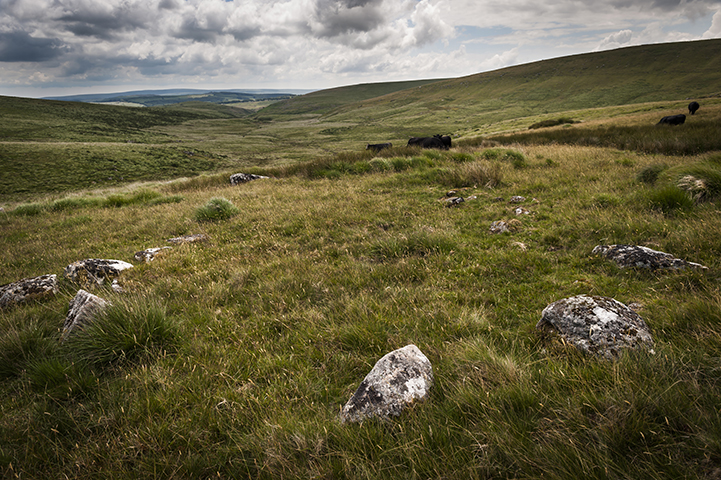
On the northern side there’s not much in the way of ‘defensive’ earthworks just a slight rise in the ground level, but the river and bogs would probably have sufficed.

On the northern side there’s not much in the way of ‘defensive’ earthworks just a slight rise in the ground level, but the river and bogs would probably have sufficed.

Back round to the western entrance where the bank and ditch start to kick in again.

Panorama looking north-west towards Sheepstor.

Hint of a stone avenue going on here on the western side, but it doesn’t go far.


A robbed out cairn just south-east of the circles.

Panorama looking eastish on what was quite a miserable wet day on the moor.

One of the larger stones with quite obvious drill holes. It seems this circle has been quite mauled in the past.

Panorama looking broadly north. The stone with the drill holes is in the foreground to the right.




Looking north with Fernworthy forest to the north east.

Stannon Tor beyond to the south east. These hut circles are about the nearest habitations to the Greywethers less than half a mile due north. Maybe these and other nearby groups helped to build the double circle?

Looking south.


A great little circle on a perfect day. Mrs. Cane sits on guard in the background.

Monumental clouds and slightly less than monumental stones, but charming all the same.

Looking NW with what appeared to be part of a cist/cairn in the foreground.


Shame it isn’t out on a wild and wind-swept bit of moorland, but hey, isn’t it a wonder to behold?!


Looking west and bringing out it’s mushroom-like quality.

Anyone else noticed this raised edge before? It’s sort of rectangular, but only just noticeable. Is it contemporary with the dolmen or maybe built later as a way of isolating the site to preserve it?

Pan looking south east from the way up from the car park. The banks and ditches are more prominent on this side.

Long shot looking south east. The Seven Barrows site is in the top right corner straddled by the A34.

Pan of the southern entrance leading down to ancient field systems.


Carnarvon’s rather plain grave set in a rather wonderful place.


The larger of the barrows further down the valley.

The barrow(s) nearest the pull in spot off the B4192 just south of Liddington Castle.


Three of the barrows on the western side of the A34 with Beacon Hill lurking in the background.

Climbing the southerly barrow with its profusion of wild plants and flowers. These really are monumentally huge mounds.

View from the top of the most southerly barrow looking at two further barrows before the group disappears beneath the ghastly A34.

Like the face of a giant green golf ball!

One of the larger galleries with extensive rubble.

At the base of the shaft with some reinforcing of gallery entrances. You can just about make out nodules of flint about 6 foot up, but the good stuff was at the bottom.



One of the reinforced columns between galleries.


Large sarcens in the garden wall of Swan House, Bray Street, Avebury Trusloe. Could these once have been part of the Beckhampton Avenue?


A small piece of ceramic found in a mole hill. You can just about make out two parallel grooves running left to right.


One of the saucer barrows with a Ridgeway backdrop.

Panorama taken from the top of one of the barrows outside the outer ring.

The larger bell barrow nearer the centre of the site.